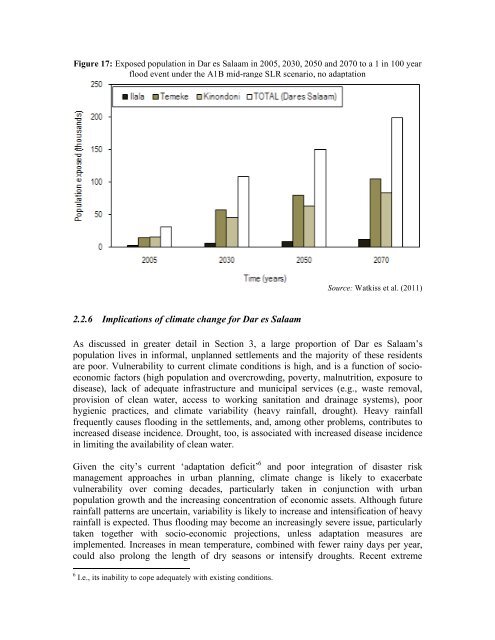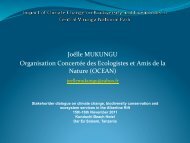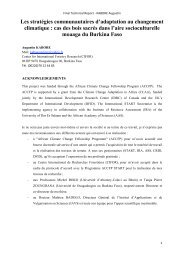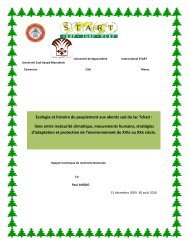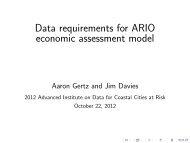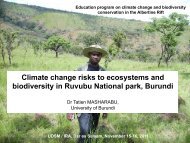Urban Poverty & Climate Change in Dar es Salaam, Tanzania:
Urban Poverty & Climate Change in Dar es Salaam, Tanzania:
Urban Poverty & Climate Change in Dar es Salaam, Tanzania:
Create successful ePaper yourself
Turn your PDF publications into a flip-book with our unique Google optimized e-Paper software.
Figure 17: Exposed population <strong>in</strong> <strong>Dar</strong> <strong>es</strong> <strong>Salaam</strong> <strong>in</strong> 2005, 2030, 2050 and 2070 to a 1 <strong>in</strong> 100 year<br />
flood event under the A1B mid-range SLR scenario, no adaptation<br />
2.2.6 Implications of climate change for <strong>Dar</strong> <strong>es</strong> <strong>Salaam</strong><br />
Source: Watkiss et al. (2011)<br />
As discussed <strong>in</strong> greater detail <strong>in</strong> Section 3, a large proportion of <strong>Dar</strong> <strong>es</strong> <strong>Salaam</strong>’s<br />
population liv<strong>es</strong> <strong>in</strong> <strong>in</strong>formal, unplanned settlements and the majority of th<strong>es</strong>e r<strong>es</strong>idents<br />
are poor. Vulnerability to current climate conditions is high, and is a function of socioeconomic<br />
factors (high population and overcrowd<strong>in</strong>g, poverty, malnutrition, exposure to<br />
disease), lack of adequate <strong>in</strong>frastructure and municipal servic<strong>es</strong> (e.g., waste removal,<br />
provision of clean water, acc<strong>es</strong>s to work<strong>in</strong>g sanitation and dra<strong>in</strong>age systems), poor<br />
hygienic practic<strong>es</strong>, and climate variability (heavy ra<strong>in</strong>fall, drought). Heavy ra<strong>in</strong>fall<br />
frequently caus<strong>es</strong> flood<strong>in</strong>g <strong>in</strong> the settlements, and, among other problems, contribut<strong>es</strong> to<br />
<strong>in</strong>creased disease <strong>in</strong>cidence. Drought, too, is associated with <strong>in</strong>creased disease <strong>in</strong>cidence<br />
<strong>in</strong> limit<strong>in</strong>g the availability of clean water.<br />
Given the city’s current ‘adaptation deficit’ 6 and poor <strong>in</strong>tegration of disaster risk<br />
management approach<strong>es</strong> <strong>in</strong> urban plann<strong>in</strong>g, climate change is likely to exacerbate<br />
vulnerability over com<strong>in</strong>g decad<strong>es</strong>, particularly taken <strong>in</strong> conjunction with urban<br />
population growth and the <strong>in</strong>creas<strong>in</strong>g concentration of economic assets. Although future<br />
ra<strong>in</strong>fall patterns are uncerta<strong>in</strong>, variability is likely to <strong>in</strong>crease and <strong>in</strong>tensification of heavy<br />
ra<strong>in</strong>fall is expected. Thus flood<strong>in</strong>g may become an <strong>in</strong>creas<strong>in</strong>gly severe issue, particularly<br />
taken together with socio-economic projections, unl<strong>es</strong>s adaptation measur<strong>es</strong> are<br />
implemented. Increas<strong>es</strong> <strong>in</strong> mean temperature, comb<strong>in</strong>ed with fewer ra<strong>in</strong>y days per year,<br />
could also prolong the length of dry seasons or <strong>in</strong>tensify droughts. Recent extreme<br />
6 I.e., its <strong>in</strong>ability to cope adequately with exist<strong>in</strong>g conditions.


